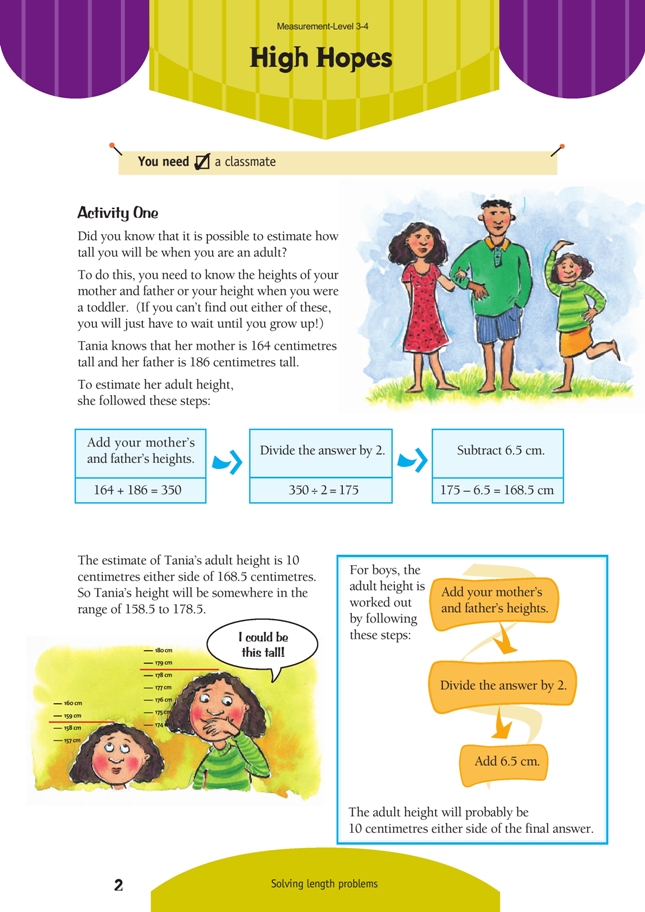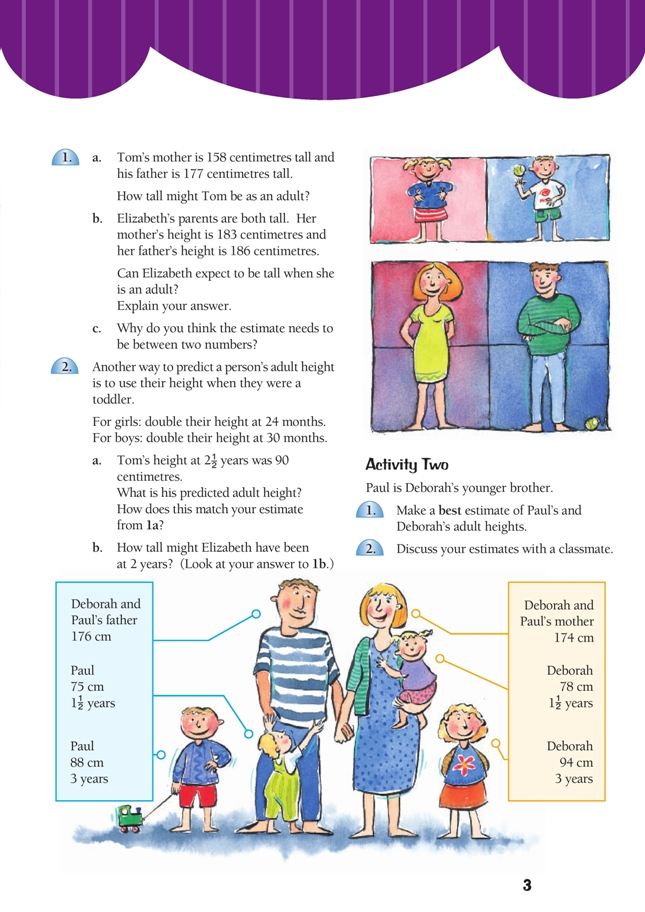This is a level 3 measurement activity from the Figure it Out series.
A PDF of the student activity is included.
Click on the image to enlarge it. Click again to close. Download PDF (409 KB)
solve length problems
a classmate
Activity One
After the students have found the average of the parents’ heights, ensure that they subtract 6.5 centimetres for girls and add 6.5 centimetres for boys. This is done because men tend to grow taller than women.
The formulas in question 2 are based on girls’ heights at 24 months and boys’ heights at 30 months. This is because boys tend to grow more slowly than girls when they are young.
Question 2b asks students to work backwards from their answer in question 1b. There, they worked out that Elizabeth’s height was likely to be between 168 and 188 centimetres. By taking this figure and dividing by 2, they can estimate that she is likely to have been between 84 and 94 centimetres at 2 years. Ask the students to discuss why they had to divide by 2. To predict the adult height from the height at 2 years, they had to multiply by 2. They need to see that to work back from adult to child, they reverse the formula, so they would divide by 2.
Activity Two
The students can estimate Paul’s and Deborah’s adult heights in two ways: they can use the formula based on the parents’ heights, or they can use the formula based on Paul’s and Deborah’s heights as children. It is worth them using both methods and comparing the results. This comparison can lead to discussion about the accuracy of such formulas and estimates. The Answers section includes useful discussion about how to use the estimate from one formula to improve the accuracy of the estimate from another formula.
Using the formula based on parent heights, students will estimate that Paul’s adult height will be between 171.5 and 191.5 centimetres and Deborah’s adult height will be between 158.5 and 178.5 centimetres.
In question 2, the students may need some help to match the data given with the formula based on children’s heights. Deborah and Paul’s heights are given at 11/2 years (18 months) and 3 years (36 months), but the formula for girls doubles the height at 24 months and the formula for boys doubles the height at 30 months. Because the data does not match exactly to the formula, the students will have to make a reasonable estimate from the data to use in the formulas.
One way to do this would be to work out the average growth between 11/2 and 3 years in 6 month periods. To do this, find the difference between the heights at 18 months and 36 months and divide it by 3 (three lots of 6 months).
This means that Deborah at 24 months is likely to be 831/3 centimetres and Paul at 30 months is likely to be 832/3 centimetres. These heights will be doubled to estimate the adult height. (See the Answers for further comment.)
Answers to Activity
Activity One
1. a. Between 164 cm and 184 cm
b. Yes. She might be between 168 cm and 188 cm, but with both parents being tall,
her genes will probably mean she will be at the higher end of the estimate.
c. Because the method gives only an approximate height. There are other
factors that determine someone’s height as well as their parents’ heights. For
example, a short parent may have very tall people in his or her extended family.
Other factors include nutrition.
2. a. Tom’s predicted adult height is 180 cm.
This fits in with the estimate in 1a.
b. Based on the answers to 1b, the actual estimate would be between 84 and 94 cm.
Elizabeth might have been about 90 cm, based on her parents being tall.
Activity Two
1–2. Answers will vary. Based on the formula and using his parents’ heights, Paul will be between 171.5 cm and 191.5 cm. However, Paul is more likely to be at the lower end, given his father’s height and the fact that at 3 years, Paul was only 88 cm. Even if he had been 88 cm at 30 months, his estimated height would have been 176 cm, so he is likely to be less than that.
Based on his average growth between 11/2 and 3 years, he was probably about 83.6 cm at 30 months, meaning he would be about 167 cm as an adult, which in this case, is outside the range based on the formula using his parents’ heights.
Based on the formula and using her parents’ heights, Deborah will be between 158.5 cm and 178.5 cm. Her average growth between 11/2 and 3 years means she was probably about 83.3cm at 24 months, meaning she would be about 167 cm as an adult, which does fit in with the first formula used.


